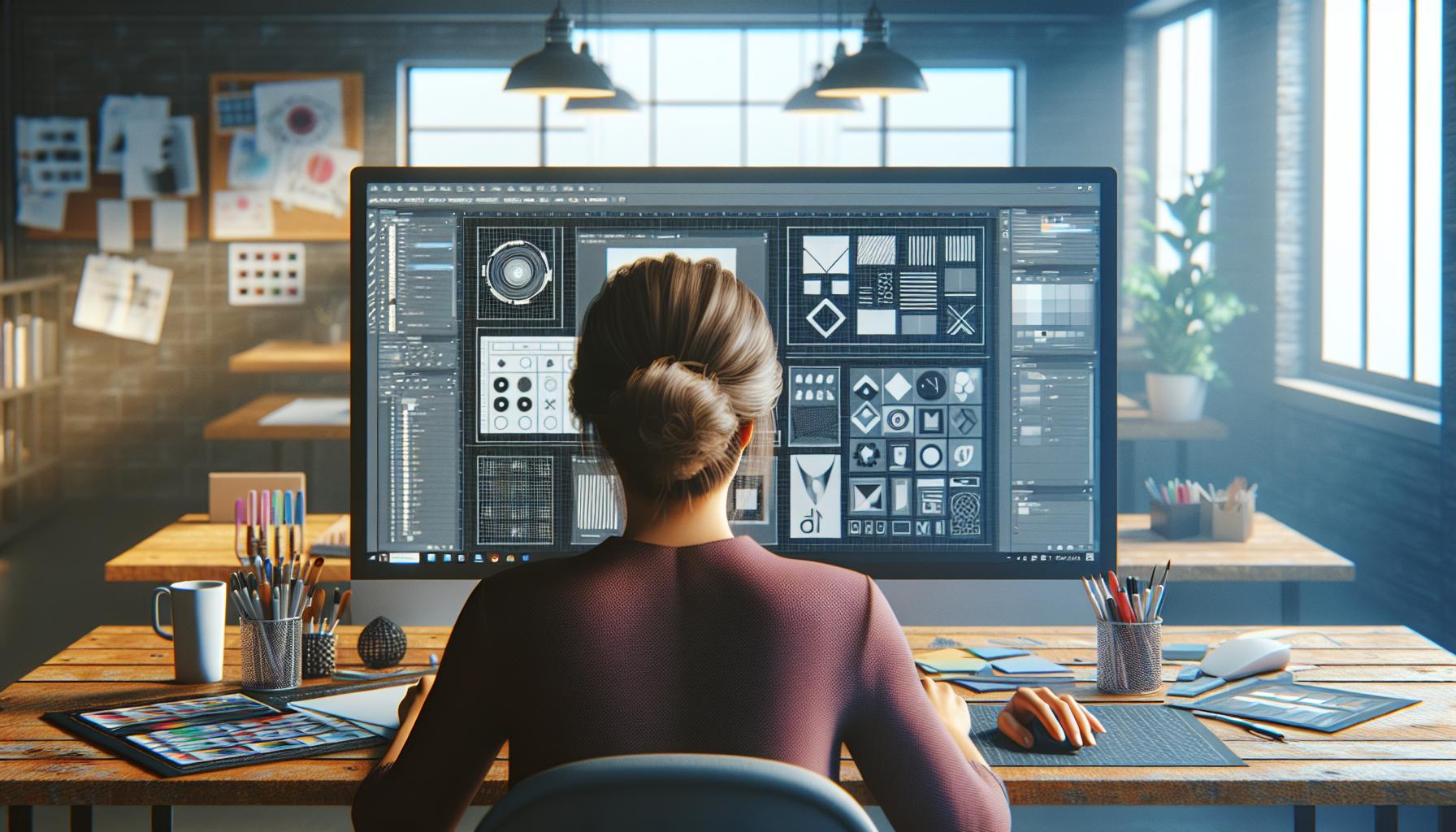In the fast-paced world of web design, Adobe Illustrator stands out like a superhero in a sea of sidekicks. It’s not just a tool; it’s the Swiss Army knife for designers who want to create visually stunning websites. With its vector graphics capabilities, Illustrator allows designers to craft everything from sleek logos to intricate illustrations, all while keeping their designs crisp and scalable.
Adobe Illustrator Web Design
Adobe Illustrator serves as a vital tool in web design. It focuses on vector graphics, which create sharp, scalable images without losing quality. Designers utilize Illustrator to craft logos, icons, and complex illustrations. The ability to manipulate shapes and paths allows for higher precision in visual elements.
Collaboration stands out in Illustrator’s features. Users can export designs in various formats suitable for web applications, ensuring flexibility in usage. Integration with Adobe Creative Cloud enhances workflow, enabling seamless transitions between applications such as Photoshop and XD.
Typography handling makes Illustrator particularly advantageous. Typography options provide extensive control over fonts, sizes, and spacing, making it easier to achieve desired aesthetics. Advanced tools facilitate the customization of text elements within designs, boosting overall visual hierarchy.
Color management also plays a crucial role. Designers can create and save color palettes, ensuring consistency across multiple projects. Furthermore, the use of gradients and patterns enriches the visual appeal of web pages.
Ultimately, Adobe Illustrator optimizes the web design process. Offering powerful tools and features, it empowers designers to produce high-quality visuals efficiently. Leveraging Illustrator’s capabilities leads to stunning, engaging, and functional web designs that capture user attention.
Key Features Of Adobe Illustrator

Adobe Illustrator offers powerful features that significantly benefit web design. Its capabilities streamline the design process for professionals.
Vector Graphics
Vector graphics form the backbone of Adobe Illustrator. These graphics maintain clarity and sharpness at any size, making them ideal for responsive web designs. Designers create logos, icons, and illustrations without loss of quality. Versatility allows easy manipulation of shapes and paths, providing endless design possibilities. Illustrator’s intuitive tools enable precise adjustments, ensuring that every detail meets specific design requirements. Users benefit from resolution independence, which enhances visual appeal across various devices.
User Interface
A user-friendly interface characterizes Adobe Illustrator. Its layout prioritizes efficiency, allowing designers to navigate tools and features seamlessly. Customizable workspaces cater to individual workflows, offering a personalized design experience. The organization of panels simplifies access to frequently used tools, reducing distractions. Essential shortcuts improve productivity, making the design process quicker. Intuitive drag-and-drop functionality enhances ease of use, enabling smooth interactions with design elements.
Benefits Of Using Adobe Illustrator For Web Design

Adobe Illustrator offers numerous advantages for web design, making it a preferred choice among designers. Its capabilities in creating vector graphics ensure that any design retains clarity and sharpness at any size.
Design Flexibility
Design flexibility stands out as a significant benefit when using Adobe Illustrator. Designers can manipulate shapes and paths without losing quality, facilitating limitless design possibilities. Users can craft intricate logos, icons, and illustrations that adapt seamlessly to different screen sizes. Additionally, Illustrator allows for easy experimentation with colors, gradients, and patterns, enriching visual storytelling. Customizing designs for various project needs becomes straightforward. With built-in tools, users can efficiently layer elements, helping to build complex compositions.
Integration With Other Adobe Products
Integration with other Adobe products significantly enhances the web design experience. Adobe Illustrator works smoothly with Adobe Photoshop and Adobe XD, streamlining workflow processes. Designers can easily export graphics for use in web projects or utilize assets created in Illustrator within other applications. This interconnectedness ensures consistency across different design platforms. Collaborative features within Adobe Creative Cloud facilitate real-time teamwork, allowing multiple designers to contribute simultaneously. The seamless transfer of assets saves time and minimizes design errors, creating an efficient workflow for web design projects.
Common Techniques In Adobe Illustrator Web Design

Adobe Illustrator offers various techniques that enhance web design efficiency and creativity. Designers leverage these methods to create visually compelling and functional layouts.
Creating Responsive Layouts
Creating responsive layouts in Adobe Illustrator involves planning for multiple screen sizes. Designers utilize artboards to refine designs and check how layouts adapt across devices. Effective use of grids ensures that elements align correctly, maintaining visual balance. Additionally, Illustrator’s vector graphics allow for scalability without compromising quality, making adjustments seamless. Designers often implement repeat grids for consistency in spacing and alignment. Incorporating guides aids in precise positioning of elements across different artboards. Lastly, exporting assets individually streamlines the process for developers, facilitating smoother integration into web environments.
Designing Logos And Icons
Designing logos and icons relies heavily on Illustrator’s vector capabilities. A focus on simplicity ensures logos remain recognizable at any size. Designers often use the Shape Builder tool for precise shapes and combinations, enhancing creativity. Custom paths enable unique icon designs that stand out in a crowded marketplace. Color is vital, so incorporating a limited palette ensures brand consistency and recognition. Illustrator’s ability to create scalable logos means they look sharp on various screens and resolutions. Using master symbols aids in maintaining uniformity across different branding materials. Collaboration features within Adobe Creative Cloud allow for real-time feedback, refining designs efficiently.
Challenges In Adobe Illustrator Web Design
Adobe Illustrator offers powerful tools for web design, yet it comes with specific challenges that designers face. Addressing these challenges can enhance workflow efficiency and overall design quality.
Learning Curve
Learning Adobe Illustrator demands time and practice. Users often struggle to master its extensive array of tools and functions. Beginners deal with complexities in navigation and functionality, leading to potential frustration. Mastering advanced techniques accelerates productivity but requires dedication. Resources like tutorials and forums can assist designers in overcoming initial hurdles. Engaging with the software regularly fosters familiarity and confidence in design tasks.
Performance Issues
Performance can pose challenges, particularly when handling large files with intricate designs. Some users experience slow rendering times, impacting workflow. High-resolution images or complex vector paths often contribute to this lag. Occasional crashes disrupt work and lead to lost progress, affecting productivity. Ensuring optimal device specifications and managing file sizes can mitigate these issues. Additionally, regularly updating software ensures access to performance improvements and fixes.
Adobe Illustrator stands out as a vital asset for web designers aiming to create visually appealing and functional websites. Its vector graphics capabilities ensure designs remain sharp across all devices while offering flexibility in manipulation and experimentation. The integration with Adobe Creative Cloud fosters collaboration and streamlines workflows, making it easier to maintain consistency throughout the design process.
Despite the challenges that come with mastering its extensive features, the benefits far outweigh the drawbacks. With the right techniques and tools, designers can overcome obstacles and harness Illustrator’s full potential. Ultimately, Adobe Illustrator not only enhances the creative process but also empowers designers to produce stunning visuals that captivate users and elevate the overall web experience.



